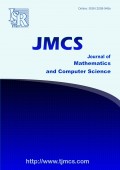Modelling the fourth wave of Covid-19 pandemic in Egypt
Authors
I. A. Moneim
- Department of Mathematics and Computer Science, Benha University, Benha, PO 13518, Egypt.
E. I. A. El-Latif
- Department of Mathematics and Computer Science, Benha University, Benha, PO 13518, Egypt.
Abstract
This paper studied the dynamics of Covid-19 in Egypt using machine learning algorithms and the epidemiological model SEIR. Among the machine learning models studied, two models showed promising results (SVR, SEGPR). Predictions of the spread of Covid-19 in the next 70 days conducted using these three approaches. The data of the fourth wave of Covid-19 in egypt taken from the WHO. The statistical measures R-Squared and RMSE used to evaluate the accuracy of these models.
Share and Cite
ISRP Style
I. A. Moneim, E. I. A. El-Latif, Modelling the fourth wave of Covid-19 pandemic in Egypt, Journal of Mathematics and Computer Science, 29 (2023), no. 1, 52--59
AMA Style
Moneim I. A., El-Latif E. I. A., Modelling the fourth wave of Covid-19 pandemic in Egypt. J Math Comput SCI-JM. (2023); 29(1):52--59
Chicago/Turabian Style
Moneim, I. A., El-Latif, E. I. A.. "Modelling the fourth wave of Covid-19 pandemic in Egypt." Journal of Mathematics and Computer Science, 29, no. 1 (2023): 52--59
Keywords
- Machine learning
- Covid-19
- SEIR model
- prediction
- Egypt
MSC
References
-
[1]
S. F. Ardabili, A. Mosavi, P. Ghamisi, F. Ferdinand, A. R. Varkonyi-Koczy, U. Reuter, T. Rabczuk, P. M. Atkinson, Covid-19 outbreak prediction with machine learning, Algorithms, 13 (2020), 14 pages
-
[2]
J. Cai, W. J. Sun, J. P. Huang, M. Gamber, J. Wu, G. Q. He, Indirect Virus Transmission in Cluster of Covid-19, Emerging Infectious Diseases, 26 (2020), 1343--1345
-
[3]
J. Cervantes, F. Garcia-Lamont, L. Rodriguez-Mazahua, A. Lopez, A comprehensive survey on support vector machine classification: Applications, challenges and trends, Neurocomputing, 408 (2020), 189--215
-
[4]
J. F. W. Chan, S. Yuan, K. H. Kok, K. K. W. To, H. Chu, J. Yang, F. F. Xing, J. Liu, C.-Y. Yip, R. W.-S. Poon, H.-W. Tsoi, S. K.-F. Lo, K.-Hu. Chan, V. K.-M. Poon, W.-M. Chan, J. Daniel, J.-P. Cai, V. C.-C. Cheng, K.-Y. Yuen, A familial cluster of pneumonia associated with the 2019 novel coronavirus indicating person-toperson transmission: a study of a family cluster, The Lancet, 6736 (2020), 514--523
-
[5]
N. El-Rashidy, S. Abdelrazik, T. Abuhmed, E. Amer, F. Ali, J.-W. Hu, S. El-Sappagh, Comprehensive survey of using machine learning in the COVID-19 pandemic, Diagnostics, 11 (2021), 11 pages
-
[6]
S. Hong, Z. Zhou, Application of Gaussian process regression for bearing degradation assessment, 6th International Conference on New Trends in Information Science, Service Science and Data Mining (ISSDM2012), 2012 (2012), 644--648
-
[7]
S. Kumar, H. Kumar, V. Dutt, P. Dixit, The role of machine learning in COVID-19 in medical domain: A survey, J. Recent Inn. Cloud Comput. Virtual. Web Appl., 4 (2020), 13 pages
-
[8]
A. A. Lashari, S. Aly, K. Hattaf, G. Zaman, H. Jung, X.-Z. Li, Presentation of malaria epidemics using multiple optimal controls, J. Appl. Math., 2012 (2012), 9 pages
-
[9]
T. P. Latchoumi, L. Parthiban, Advanced overlap community detection by associative rule mining and multi-view ant clustering, Int. J. Eng. Tech., 7 (2018), 21--29
-
[10]
S. A. Lauer, K. H. Grantz, Q. Bi, F. K. Jones, Q. Zheng, H. R. Meredith, A. S. Azman, N. G. Reich, J. Lessler, The incubation period of coronavirus disease 2019 (COVID-19) from publicly reported confirmed cases: estimation and application, Ann. Intern. Med., 172 (2020), 577--582
-
[11]
C. J. Lu, C. H. Chang, C. Y. Chen, C. C. Chiu, T.-S. Lee, Stock index prediction: a comparison of MARS, $\mathrm{BPN}$ and SVR in an emerging market, BPN and SVR in an emerging market, In Proceeding of the IEEE International Conference on Industrial Engineering and Engineering Management, 2009 (2009), 2343--2347
-
[12]
Y. Mohamadou, A. Halidou, P. T. Kapen, A review of mathematical modeling, artificial intelligence and datasets used in the study, prediction and management of COVID-19, Applied Intelligence, 50 (2020), 3913--3925
-
[13]
I. A. Moneim, Seasonally varying epidemics with and without latent period: A comparative Simulation Study, Math. Med. Biol., 24 (2007), 1--15
-
[14]
I. A. Moneim, An SEIR Model with infectious latent and a periodic vaccination strategy, Math. Model. Anal., 26 (2021), 236--252
-
[15]
I. A. Moneim, D. Greenhalgh, Use of a periodic vaccination strategy to control the spread of epidemics with seasonally varying contact rate, Math. Biosci. Eng., 13 (2005), 591--611
-
[16]
T. Odagaki, Self-organized wavy infection curve of COVID-19, Scientific Reports, 11 (2021), 1--7
-
[17]
T. Pavlicek, P. Rehak, P. Kral, Oscillatory dynamics in infectivity and death rates of COVID-19, Msystems, 5 (2020), 7--20
-
[18]
I. Pereira, J. M. Guerin, A. G. S. Junior, G. S. Garcia, P. Piscitelli, A. Miani, C. Distante, L. M. G. Goncalves, Forecasting Covid-19 dynamics in Brazil: A data driven approach, Int. J. Environ. Res. Public Health, 17 (2020), 8 pages
-
[19]
I. Rahimi, F. Chen, A. H. Gandomi, A review on COVID-19 forecasting models, Neural Comput. Appl., 2021 (2021), 11 pages
-
[20]
J. M. Read, J. R. E. Bridgen, D. A. T. Cummings, A. Ho, C. P. Jewell, Novel coronavirus 2019-nCoV: early estimation of epidemiological parameters and epidemic predictions, medRxiv, 2020 (2020), 12 pages
-
[21]
] M. Singla, D. Ghosh, K. K. Shukla, A survey of robust optimization-based machine learning with special reference to support vector machines, Int. J. Machine Learning Cyber., 11 (2020), 1359--1385
-
[22]
B. Suvarna, B. L. Nandipati, M. N. Bhat, Support vector regression for predicting covid-19 cases, Eur. J. Molecular Clinic. Med., 7 (2020), 4882--4893
-
[23]
G. Zaman, S. H. Saker, Dynamics and control of a system of two noninteracting preys with common predator, Math. Methods Appl. Sci., 34 (2011), 2259--2273
-
[24]
N. Zhang, J. Xiong, J. Zhong, K. Leatham, Gaussian process regression method for classification for high-dimensional data with limited samples, Eighth International Conference on Information Science and Technology (ICIST), 2018 (2018), 358--363

